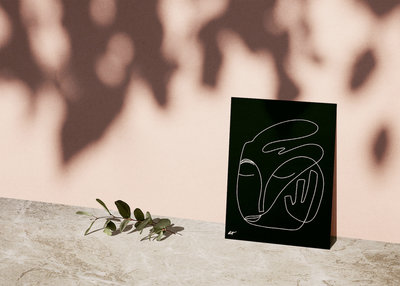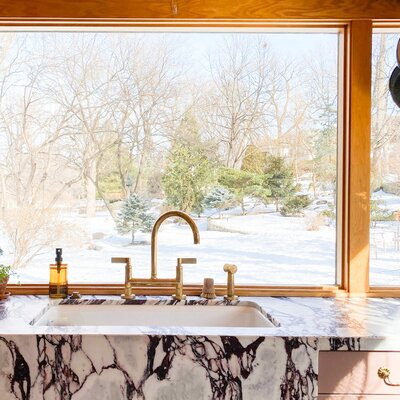

Another dead houseplant? Say it isn’t so. I recently hosted a funeral for a hoya Hindu rope plant, which wasn’t the first of my houseplants I’ve killed and likely won’t be the last either.
The good news is that plants are pretty predictable. Since there are just a few things they need to survive and thrive—water, sunlight, soil—it’s fairly easy to pinpoint where you went wrong in your plant parenting.
Here to help is Emily Lynge, who, along with her husband Bobby, owns Grow Plant Shop in Fort Worth, Texas. They began Grow, which is operated out of a 1978 Airstream Sovereign that they renovated themselves in 2018, because, “Quite simply, we love plants,” Emily says. “Our lifestyle simply wouldn’t be the same without our plants. It seems that connecting nature with your daily routine and throughout your home can even out your mood and heal the soul.”
Operation Heal the Soul is in full effect. To make sure your plant friends stay happy and healthy, let’s break down the most common reasons your houseplants are dying—and how you can rescue them before it’s too late.
Your plant isn’t getting the right amount of sunlight.
To create an ideal sunlight situation for your houseplants, “It’s crucial to understand the amount of sunlight your plants receive in their natural habitats,” Emily says. If a plant grows in full sun in the wild, it will require several hours of direct sunlight through a window. Others that naturally live in the shade or filtered sun won’t require direct sunlight, but will still appreciate a moderate amount of consistent, indirect light.
How do you know if your plant is getting too much sun?
“The most obvious sign that your plant is receiving too much sun would be, you guessed it, sunburn,” says Emily. This can appear as discoloration, bleaching, or crispy edges on the leaves. “Unlike the humans that care for these plants, sunburn is permanent damage to your plant.” Simply move it to a spot that doesn’t receive as much sunlight, or hang sheer curtains to diffuse the sunlight.
Which plants are best for low light?
There are some plants that can notoriously champion through low light levels, including ZZ plants, pothos, snake plants, and certain philodendrons.
Your plant has root rot.
Root rot, the deterioration of the plant’s roots, is devastating for your plants. Just ask my long gone fern and aloe vera plants. Root rot occurs when water pools at the bottom of your planter, so the roots cannot get oxygen, essentially drowning your plants. It can happen if your houseplants are planted in a pot without a drainage hole, if the soil is not well-draining enough, or if you water your plants too often.
How do you know if your plant has root rot?
“If you notice mushy stems on your plant and sad droopy leaves, often with dark spots, your plant may have root rot,” says Emily. She recommends pulling your plant out of the planter to inspect the roots. If they’re slimy and fall apart to the touch, your roots are rotten.
Can a plant with root rot be saved?
Yes, if it’s caught in time. First, remove the rotten roots, then spray the remaining healthy roots with a diluted rubbing alcohol to ensure the rot does not spread. When replanting, use a planter with drainage and well-draining soil.
How do you prevent root rot?
First, ensure that your planters have proper drainage. Then only water your plants when they need water. A good rule of thumb is to wait until the top inch of soil is dry before watering again.
Your plant isn’t getting enough water.
“Droopy or crispy leaves is a common indicator of a thirsty plant,” says Emily. Most plants need a thorough watering about once a week, except cacti and some succulents, which can tolerate a biweekly watering schedule. “You’ll notice when these plants are thirsty because they start to look flimsy or wrinkly.”
Your planter has poor drainage.
Plant Parenting 101: Plant your green friends in pots that have drainage holes. This ensures that the water can pass through the pot, helping to prevent root rot.
If your planter does not have drainage, you have two options. “You can either drill a hole yourself, or leave the plant in its nursery pot, and simply use the non-draining planter as a decorative pot,” Emily says. “Pull the plant out of the decorative pot when you water so that the water does not drain into it.”
Your plant needs to be repotted.
Houseplants are just like us, occasionally outgrowing our homes. In order to stretch its roots and continue to grow, you occasionally need to repot it in a larger pot.
When should you repot a plant?
“If you notice roots swirling heavily around the inside of the pot or growing out the drainage hole, it is time to repot your plant,” says Emily. If you notice your once-thriving plant starting to look sad, it could be root-bound and no longer receiving adequate nutrition from the soil.
How often does my plant need new soil?
Emily recommends freshening up the soil in your planter about once a year.
Your plant is experiencing transplant shock.
If you’re moving a fiddle-leaf fig tree in the middle of a Minnesota snowstorm, that could shock it. If you’ve relocated it from a sunshiny spot to a shaded corner, that could trigger shock too.
Why does plant shock happen?
There are three common reasons houseplants experience shock: a dramatic change in temperature, exposure, or humidity. “We have found this is pretty common when we import our exotic plants,” Emily says. “A quick solution for us is to keep our plants in our greenhouse until they’ve had time to adjust to their new environment and grow a couple of new leaves.”
What does a plant in shock look like?
The symptoms of plant shock are pretty obvious. Leaves will turn yellow or brown, wither or darken, and fall off to a light touch.
What should I do to prevent plant shock?
If you’re purchasing from a local nursery, there’s a good chance that the light and humidity levels aren’t too different from your home. “Depending on the plant you’re bringing home, we suggest finding a spot with bright, filtered light and letting that plant bask in an ocean of UV goodness,” Emily says. “This will keep the plant happy, warm, and photosynthesizing right on schedule. A boost of humidity also never hurts.”
Your plant is infested with spider mites.
There’s nothing good about spider mites: they’re a nuisance to houseplants, difficult to get rid of, and can travel quickly through the air from plant to plant.
How do you treat spider mites?
First you need to quarantine the plant from other houseplants, then use a Bonide Systemic Insect Control spray mixed with water to completely soak the foliage and soil of the plant. You may have to repeat this process several times to completely get rid of the infestation.
“Spider mites are tiny, dust-like creatures that gather on either side of the leaves, close to the petiole, or stem, of the plant,” Emily says. “Spider mites make very fine webs and literally suck the life out of the plant, leading to droopy and discolored leaves.” If left untreated, your plant will eventually die.
In addition to spider mites, there are other common pests to keep an eye out for too, including aphids, thrips, and mealy bugs, all of which can massacre a plant if left untreated.
Is there a natural way to treat and prevent a plant infestation?
For an all-natural remedy to plant infestation, Emily recommends watering your plant with a diluted neem oil mixture once a month, as well as wiping the leaves down with neem oil.
You’ve overfertilized your plant.
If your houseplant’s leaves appear to have severe burns, you could have overfertilized it. Emily recommends fertilizing at a half strength from what the packaging recommends to ensure you don’t burn the foliage.
Using all-natural products will help avoid this too. “Earthworm castings mixed with your soil, or watering with liquid seaweed or fish emulsion won’t harm your plant if used regularly,” Emily says.
Help, my plant looks sad/limp/maybe dead! Now what?
“If your plant is looking sad, the first thing to do is to check the soil,” Emily says. “Is it bone dry? Your plant probably needs to be watered. Is the soil wet? Check the roots. If the soil and roots are okay, check the leaves. Any pests?” Do a thorough inspection of your houseplants each time you water to ensure they’re growing well.
You could also snap some photos and reach out to a trusted nursery, especially if you purchased the struggling plant from them. There are also plenty of online forums dedicated to chatting about plants. “Most of them welcome all sorts of questions and there is a solid chance that someone else in the group has experienced the problem that you’re having,” she says.
Now you know: sun, soil, and water. Happy plant parenting, friends!
P.S. You can support Grow Plant Shop via their online shop!
These are a few of our favorites from their wide selection of offerings:
Megan is a writer, editor, etc.-er who muses about life, design and travel for Domino, Lonny, Hunker and more. Her life rules include, but are not limited to: zipper when merging, tip in cash and contribute to your IRA. Be a pal and subscribe to her newsletter Night Vision or follow her on Instagram.
BY Megan McCarty - December 18, 2020
Most-read posts:
Did you know W&D now has a resource library of Printable Art, Templates, Freebies, and more?
take me there
Get Our Best W&D Resources
for designing a life well-lived




Thank you for being here. For being open to enjoying life’s simple pleasures and looking inward to understand yourself, your neighbors, and your fellow humans! I’m looking forward to chatting with you.
Hi, I'm Kate. Welcome to my happy place.






















“Blast it with light, give it a little fertilizer, water it when it’s dry, and it’ll say ‘Life is worth living! Let’s regrow!’ You could have the same luck with plants like pothos and monstera, as long as there’s a little vine or stem left.”